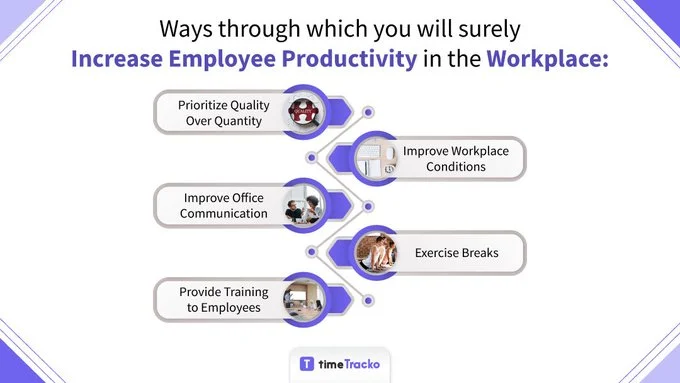Major Productivity Challenges and A Guide To Conquer Them
Major Productivity Challenges and A Guide To Conquer Them
“The simple act of paying positive attention to people has a great deal to do with productivity.” –Tom Peters
Productivity involves being creative and coming up with something different from others that will benefit you and others. A company’s efficiency and long-term success are determined by its productivity.

However, there is a misconception about productivity, i.e., being productive is being busy all the time.
From my perspective, productivity is about completing the work or getting the work done and developing your self-confidence, creativity, motivating yourself, and analyzing your ability and how much effort you can make.
Increasing your productivity can help you achieve your goal as quickly as possible. Productivity is the key to happiness.
The impact of productivity in organizations
Productivity directly impacts a company’s profitability. Productivity refers to the ability to efficiently complete organizational processes.
A low productivity rate in an organization means the company cannot produce what it needs in a timely manner. Due to the fact that the production of each product is more expensive, the return on investment (ROI) and profit of each product are lower.
As a result of higher productivity, a product or service is able to be produced more efficiently (or at any rate as efficiently as is desirable), leading to a higher profit or positive return on investment for the company. This boost in profitability is especially vital in the hospitality industry, where profit margins for restaurants can be particularly impactful, contributing to their overall success.
How does low productivity impact the organizations?

1. A reduction in profitability
It is well known that poor productivity (or work rate) is associated with poor performance by employees, which is ultimately reflected in the quality of products. It is the end-user’s dissatisfaction that will bring down the profitability of the product.
A resource that isn’t performing well also reduces profit margins due to time and cost spent on it. Since the production cost exceeds or surpasses the billing cost, it is almost equal to the cost of billing. Profit margins for an organization are therefore heavily influenced by productivity.
2. Employee disengagement and lower team morale
In the case of decreasing productivity, it affects engagement and morale within a team. The level of initiatives taken by employees will begin to decline. In addition, employees tend not to be interested in solving project problems.
Disengagement among employees results in a low level of team spirit. The performance of your team will be impacted if work does not progress well or team members do not feel valued. The failure to do so may cause them to leave your organization if they do not feel valued.
3. Workplace toxicity and high employee turnover
Employees who are unproductive require an external influence. On the other hand, if their managers are also reacting in a negative manner, it could negatively affect the working environment.
An in-depth analysis of the relationship between workplace toxicity and employee turnover is provided in this study. It is likely that existing employees will depart the organization. Moreover, by disclosing the details of your toxic work environment, you are scaring away prospective employees.
4. Suboptimal utilization of workforce
No matter how fully employed an employee is, that does not imply that they are productive. You may find out that they are spending their time on non-billable admin tasks or otherwise not providing any value to your company.
Hence, their productivity will further be reduced as a result. There is also a possibility that the other employees could be overworked on high-priority billing tasks.
5. Delay in project timelines
An organization’s inefficiency is caused by low productivity. A team with unmotivated employees begins with lowered spirits, which eventually results in missed deadlines.
Being productive is primarily about accomplishing more in a shorter period of time. If the project’s performance declines, the project’s due date will be missed, resulting in dissatisfaction from the client.
You should expect that when your firm fails to deliver a project on time, your clients will look for alternate solutions. Competitive actions will result in the loss of an existing client, as your competitors will take advantage of the situation.
How does high productivity impact the organizations?

1. Competitive advantages
The low production cost of this business makes it easier for it to compete in the market with other like-minded companies. As a result, it has the ability to offer consumers a competitive price advantage over other businesses.
2. Resources utilization
It is possible to utilize resources that are currently unemployed, including the capacity of unutilized machines and also the sunk costs that have been accrued.
3. Customer satisfaction
It will be possible to successfully achieve customer satisfaction by meeting their needs and/or demands on time or prior to the expected date.
4. Increasing profits
Greater productivity is meant to be accompanied by higher production, which will then be translated into increased sales, and thus a higher profit.
5. Reserved fund
In order to deal with the uncertainty in the future, a reserve fund can be created from the excess profits.
Learn more: Working Remotely? Follow These Tips To Enhance Your Work Productivity👩💻💯
What makes people unproductive?
Unproductive people usually don’t plan their time in a way that makes them able to achieve their goals. Lack of direction can lead to productivity stalls for some people. Although someone may have a clear understanding of their ultimate goal, they do not know how to attain it.
It is common to experience this when performing a task you believe to be challenging or when you have never handled it before. The problem can also arise if you are overwhelmed with many other things that you must undertake at the same time
1. Sacrificing your precious sleep
It is easier to cut back on sleep when your workload is high, or when your goals are ambitious enough. Sleep deprivation does have negative effects on productivity. It affects career and success negatively if sleep is sacrificed for work. Exhaustion can result from an insufficient amount of sleep.
When you are exhausted, your mind cannot work properly. The result of losing concentration is errors, which has a negative impact on productivity.
Sleep deficiency causes, among other things, misinterpretations of tasks at work, missing important information, and making mistakes frequently. Sleep deprivation increases our stress levels and decreases our creativity.
In spite of the fact that you may be one of the fortunate few who are able to be remarkably productive with less than 4 to 5 hours of sleep, the rest of us must get at least six hours of sleep each night in order to maintain optimum neurological health. There is no doubt that your sleep is precious, so make sure to get adequate sleep.
2. Proactively rather than reactively
If you’re constantly checking off things from your to-do list, but still feel that you haven’t accomplished anything, you’re not alone.
Reactions can be reactive. You spend your work hours responding to calls and putting out fires instead of completing your most important tasks.
The alternative to being proactive is to react when you don’t have a plan in place. The first thing you do when you open your email client is to answer emails.
Low-impact, easy-to-undertake activities are naturally appealing to us. Checking them off our to-do list only takes a few minutes, and the dopamine surge we receive for completing the task is highly rewarding.
However, this is a trap. Reacting too much will prevent you from achieving important tasks that will affect your business.
Give yourself a moment to reflect on how you are approaching your first few hours at work each day. Would it be helpful if you developed a morning routine? Would you like to work in an environment that empowers you while allowing room for your creativity to thrive?
3. Performing multiple tasks at once
Considering the busy nature of today’s world, it is almost impossible to not get involved with multiple tasks simultaneously. The scientific consensus suggests we should stay away from multitasking as much as possible, even when we can’t avoid it.

Multitasking might be a last resort when you’re trying to cope with a heavy workload or you want to finish your daily tasks as fast as possible. It takes a while for your thinking process to become tangled up.
It’s a straight trip to unproductivity for jobs requiring critical thinking and problem-solving skills.Changing tasks quickly deters productivity, as recent research has shown.In the study, the most concerning conclusion was that the brain changes had an impact on participants even when they were not multitasking.
According to the findings, chronic multitaskers’ brains were less efficient and effective even when they were focusing on a single task. Human beings do not possess the capability to multitask the way computers can. It is advisable not to attempt it. We lack the ability to multitask.
Learn More : Boost Your Productivity With These Time Management Tips⏰✅
4. Lack of motivation
To overcome those inevitable times of low motivation is a major challenge for self-employed individuals. The threat of firing is always there with 9 to 5 jobs. In the world of self-employment, it’s more complicated.
Motivating yourself is a good way to enhance your productivity. However, we don’t have the luxury of sitting around and waiting. Often, motivation will appear after you begin working on something and carry you through to the completion of the project.
Put a timer on and focus on starting instead of worrying about motivation. During this time, you should work on your project without distractions for 10 or 20 minutes. Having become more motivated after the alarm has gone off, do not be surprised if you continue to work.
Learn more: 10 Ways to deal with stress and stay motivated 💪🎯
5. Inconsistency in discipline
If you fail to work at a job, you could be fired.
You won’t see the effects immediately if you slack off on your own business. Slacking off might lead to losing customers and clients before you’re forced to do so.
Having the power to make all the decisions when working from home is easier than dealing with other people. If you lack discipline, your chances of success will be absolutely ruined. As self-employed people, we have to be constantly aware that it is all too easy to slip into bad habits.
Being human doesn’t mean we’re perfect. However, we can train ourselves to maintain a schedule and put forward consistent effort.
Conscious effort and time are necessary for building discipline. Getting disciplined next week isn’t going to happen magically. We build discipline over time, like muscles gain strength over time.
6. Focusing on the wrong thing
The smartphone is taking over the way we focus, concentrate, and think. If one weren’t wasting so much time, imagine how productive one would be.
We have increasingly come to be associated with smartphones as the main cause behind the increasing need to multitask. Biologically speaking, we aren’t accustomed to multitasking and aren’t trained to do it. Hence, our attempts are useless.
I believe that technology addiction is a very real phenomenon. In this situation, if you have difficulty controlling yourself from touching the phone every now and then, you are gradually beginning to feel like an addict. And this negatively affects both your productivity as well as your emotions afterward. There are indications that we are not really becoming smarter because of our smartphones.
Some tips how you can increase your focus :
- Meditating or setting daily goals can help you increase your focus.
- Eliminate all distractions from your work space.
- Focus on time management and focus training.
- It is possible to work on time management and focus training.
You can achieve a greater degree of concentration by compartmentalizing your time, which allows your brain to isolate one task at a time, so that you do not constantly have to break your concentration to do other things.
7. Unable to move forward due to uncertainty
Feeling like an impostor ever happened to you?
Can you tell me what would happen if I started this new company or if I took on this client, and things turned out terribly? Please give me a detailed description of this scenario. In order for you to realize that the worst case scenario may not be as bad as you think, you must see it all laid out on paper. Despite whatever happens, you can get back on track.
It is now time to think about all the possible consequences if everything goes smoothly. Imagine that you could gain new skills, make new connections, and increase your income as a result of going on this course.
Isn’t it easier to decide this way? Self-doubt arises and disappears. Despite this, I still haven’t been successful in making it disappear forever. Fortunately, you can cope with it, keep going anyway and build confidence little by little. Continuing to do so will allow you to rack up small victories.
Learn more: 20 Fun Games to Play At Office When You are Bored🎮🤳🏻
Why is productivity important for huge corporations?
1. Make your business more profitable

The profitability of businesses increases when products and services become cheaper to produce. Productivity increases as a result of fewer labour hours being invested in the production of these goods and services.
While it’s true it’s possible for businesses to reduce their employee numbers in order to achieve the same productivity, there are many reasons as to why it is best to maintain the number of employees to benefit from a boost in production.
2. Lowered operational cost
There are a number of ways in which companies can reduce their operating costs. It is likely that when employees improve their individual workflow, then they will either be able to accomplish more within the same amount of time or their hours will be reduced to accomplish the same amount of work.
The implementation of technology can also help to reduce the operational cost of a company. There are several initiatives being undertaken to enhance productivity among the workers such as introducing flexitime or three-day weeks, which increases productivity by increasing employee motivation and engagement and reducing stress levels.
3. Enhanced resource efficiency
Resources aren’t utilized to their fullest potential by most businesses. Occasionally, employees may not be able to do their work because they are also busy, but at other times they are in the mood for work.
With a better human resource management system, organizations are able to reduce costs and increase productivity through more effective marketing staffing agency, role distribution, and role allocation.
The utilization of better workflow systems can allow the business to identify and rectify overlapping roles, as well as assign duties to employees that may not be used to the full extent that they might have been.
4. Improved customer service
It’s evident throughout the company that we give customers the attention and time they need. We provide undisrupted systems, and our customers are observant of this.
As a result, the business increases its profits when customers are satisfied, which means the managers and stakeholders will also be satisfied.
5. Improved competitiveness
It doesn’t matter how fast, better, or more efficiently you do something than your competitors, that gives you an advantage. The increase in productivity also translates into an increase in competitiveness.
You can charge less for your products if you are able to produce them more economically than your competitor.
Providing your customer service more rapidly than your competitor will give you the advantage of serving more clients, or improving your customer service value proposition as you will have more time to dedicate to your customers.
Despite the many benefits organizations enjoy as a result of increased productivity, employees may not be as familiar with the benefits as accountants and other finance professionals.
6. Reducing employee burnout
A lack of time can lead to stress, exhaustion, or total burnout when people have too much to do.
A more efficient system – for example reducing the amount of time spent on daily activities or redistributing responsibilities – enables people to be more efficient with their time and meet their responsibilities within the allotted period.
Both the employer and the employee will benefit from this. Those who are better at time management tend to be more organised, relaxed, and effective, focusing on their everyday tasks instead of worrying about all the things they haven’t accomplished.
7. Increase engagement
People who work more productively tend to be more engaged in their jobs as well. An individual’s willingness to engage is often the result of a combination of factors, including their relationship with their leader, the level of autonomy they feel, and their understanding of the work they are responsible for.
You will be more focused and engaged when you feel that the effort you make towards your work is making a difference and you are not waiting for things to happen.
By taking additional steps to make their work lives more organised as a result of taking control of the situation, employees can become more focused, committed and engaged at work or they can change jobs to one that suits them better.
Learn More: Tips for Establishing Effective Communication in Remote Team🗣️💬
8. Enhancing well being
Personal wellbeing is also one of the benefits that come with increased productivity. It is possible to describe well-being as being in a state of health and comfort as well as being happy.
It is true that when you have a greater sense of control over your workload, you are able to have more control over your life, with more time for exercise, eating healthy food and even resting during the times when you need it.
When you are less stressed, you can pay attention to your body better, which in turn will allow you to give it what it needs more. You can have everything you desire in life as long as you work towards it.
Learn More: Importance of Time Management in the Workplace⏱👨🏻💼
Key factors that influence productivity
A vague definition of productivity can be misleading, so you should know what productivity is and how it differs from efficiency.
Production efficiency is usually considered an indicator of an organization’s efficiency, but in the case of employee productivity, it can refer to how much is produced by them over the course of a year or two. Some factors that influence productivity are listed below:
1. Work environment
We all know how infuriating it can be working in a negative or toxic working environment. As a business owner, be sure to establish a powerful atmosphere based on the values of your company. Your employees should feel supported, valued, and secure in their workplace.
Keep the focus on honesty and cooperation when possible, and don’t forget to reward your employees when they deserve it. As a employer, it is your job to provide your employees with an environment in which they can cooperate, compete, and emphasize with their colleagues.
Employees who work in such an environment develop healthy work habits, which contributes to a more productive workplace.
Learn More: Tips to Maintain a Healthy Work Environment and Team Productivity 👩💻 📈
2. Tools
You can directly impact productivity at the workplace by providing your employees with the right tools. A poorly trained employee will work slower and mismanage resources, which will then result in a company losing money.
As a result of poor management practices and a lack of access to the necessary tools, disengagement among employees may increase, which can negatively impact productivity, efficiency levels, and overall productivity in the workplace.
Learn more: Best Productivity tools for Employee Working From Home 🧰✔️
3. Training and career development opportunities
In today’s modern workplace, it is of great value to ensure all employees feel like their employer is invested in their professional development and will provide them with the necessary training opportunities as they make their way through the company’s organization.
Perhaps it’s time to implement a company-wide training program if you haven’t done so yet. The result of a poorly trained employee is that he or she does not know what to do or how to do it faster. This can negatively impact productivity in the organization.
Using microlearning is one of the best ways to facilitate training programs. The information and knowledge you give your new employees in this human resources tool will help them perform better at work.
As well as that, be sure that team members have the opportunity to grow within the company hierarchy, so that they won’t end up feeling stuck in the same position for too long.
4. Staff should be trained on the process
You can provide a positive first impression to your employees from the moment they are hired, onboarding, and performing tasks. By establishing processes, you can provide employees with a positive working experience from day one.
A lot of trial and error goes into developing these processes and it is time-consuming. You can have all the information you need about your business – and, more importantly, you will be a lot more efficient and organized once you have it.
The majority of recurring tasks and projects for the vast majority of companies with high productivity levels are built with processes.
Example of employee offboarding: Workers are often forgotten to revoke their access to their platforms when they leave, leading to privacy concerns.
A project management tool that serves as both an employee and employee management tool allows your HR personnel to easily remove an employee’s access to company tools and confidential information with a few clicks.
HR departments can do this more easily, while employees are also able to focus on other tasks since they can offboard an employee more quickly.
5. Pay structure
It is obvious that monetary benefits are one of the reasons why your employees took a job with your company, as they have bills to pay, children to take care of, and goals to achieve.
In order to motivate your employees, you can use this as a motivational tool, by explaining clearly and transparently how your pay structure works and what you take into account when deciding whether an employee deserves a promotion or raise.
6. Technology and production factors
A modern working environment is inextricably linked to technology. The technology used by modern companies tends to make them more prosperous as it supports employees while they perform their tasks, especially when the work is technical in nature.
The installation of an AI-driven business telephone framework, for example, will allow the smooth exchange of information between departments. Furthermore, they can focus on other tasks as opposed to spending time going back and forth on a topic, giving them more time to manage time wisely. In the contact center industry, AI platforms purpose-built for call center productivity like AmplifAI help organizations go beyond dashboards, automating insights and turning agent performance data into measurable coaching actions.
If a company is unwilling to utilize modern technology, then the workplace can become extremely burnt out, which has a strong impact on productivity.
7. Workplace ergonomics
The work environment also has a range of characteristics that influence the productivity of an organization, but beyond that, additional factors can also play a role in its productivity. Although these factors aren’t included in the main factors, they still have a direct impact on individuals’ ability to do their jobs.
Low productivity can be caused by several factors, including:
- The temperature at the workplace
- Quality of air
- Poor Lighting
- Hydration
- Office Space Layout and Design
Learn more: Effects of Working in an Unhealthy Work Environment 🤯🙅♂️
What are the major challenges to productivity?
In order to improve Productivity, we must address a number of challenges, including the following:
1. Disengagement between an employer and an employee
In addition to overwork and inefficient processes, employee disengagement is often the result of excessive management. If operational concerns are to blame, it is a solvable problem. There are many reasons why a member of the team might not feel engaged at work.
Prior to engaging employees, it’s important to understand their disengagement. A survey is conducted anonymously to investigate employee engagement in terms of productivity, organizational health (management and organizational effectiveness), and operational efficiency.
Your team can take steps to solving problems such as overworked employees, work-related frustrations, or a sense of unsupported if you notice that employees are feeling unsupported or overworked. You will need to find other ways to obtain insight without conducting a survey.
Taking a look at employee monitoring and productivity software data could serve as a good starting point for 1-on-1 meetings with your team members. You will be notified by this software when operational processes do not meet standards and in the first place go ahead and fix the problem.
2. Management of performance in an ineffective manner
Without a solid performance management system in place, your organization is unlikely to function at all, let alone effectively. It is the duty of management to continuously evaluate performance and continue to optimize the performance of teams both on-premise and remotely.
The person in charge of this task may be a project manager, who is responsible for monitoring and comparing the time-tracking software with accounting and invoicing, and for making changes within the company.
As well as making changes to the structure, leaders must ensure that the changes they are making will have an effect on the policy and are feasible within it.
Make sure someone is responsible for performance management and evaluate your current setup. In addition to overseeing the monitoring software and holding regular meetings on performance, they will implement and evaluate the changes made.
3. The excessive number of meetings
There are lots of distractions at the workplace today: open office spaces and app notifications make your job more difficult. Yet, meetings are often overlooked as one of the biggest distractions of all!
You’ve probably experienced days where you’ve had back-to-back meetings or even days where you had short 30 minute periods between, which were not quite enough to get back on track, but enough to feel productivity evaporate.
The culture of your company should trickle down to aspects such as how you conduct meetings and how that can impact the company’s personnel. Make sure your culture is fun, dynamic, and that meeting techniques don’t sap productivity and make members feel demoralized.
By doing such things as setting up a signal for when someone needs absolute distraction free time, no meetings can be set up on Thursdays, and silent rooms can be created in the office.
4. Employees’ performance is not being tracked well
You may not attribute your productivity issues to poor tracking, but neither do you benefit from it. Moreover, it provides a misleading impression of what is truly happening during working hours.
The lack of accurate tracking, the inaccurate tracking, or the inconsistent tracking do not provide adequate insight into the efficiency of processes, the inefficiencies resulting from them, or other challenges related to productivity.
In consequence, changes might not be implemented, resulting in the same issues with productivity. The alternative to using software like timeTracko is piecemealing or manually tracking the activity, which can be incorrect to a significant degree.
We recommend synchronizing time tracking with timeTracko, which provides employee monitoring and time tracking tools, including screen monitoring, network alerts, and communication logging.
Learn More: Best Software Tools To Help You Work Remotely 👨🏻💻
5. Non-work related reasons for productivity challenges
Personal challenges can be one of the biggest barriers to productivity. The problem is that too much pressure on oneself to squeeze out work only leads to high stress and burnout during those times.
To ensure your employees feel supported rather than squeezed during these times, it is critical to take into consideration your company culture.
It is often forgotten by companies that employees are also human beings. However, as indicated in the introductory remarks, productivity isn’t just a matter of providing the money and getting the job done.
People’s ability to focus and complete tasks can be significantly affected by non-work-related stress. Consider giving people the time and support they need to recuperate instead of wasting resources and creating dedicated company ambassadors.
Your primary focus should be ensuring that your employees are valued and contributing to the success of your organization. Contributing to this process is supporting them and enabling them to feel more productive.
Guide For Conquering These Major Challenges

Most obviously, productivity is directly tied to profitability, which is typically the number-one objective of any corporate enterprise.
It is well known that low productivity is one of the main contributors of falling behind not only in sales, but in a competitive market as well.
It is normal in the workplace to encounter productivity challenges from time to time, but there are ways that your team can work together to overcome these problems.
Some tips for overcoming these major productivity challenges in the workplace are given below:
- Establish home office rules.
- Implement collaboration tools
- Send end-of-the-week update emails
- Align responsibility with authority to make decision
- Turn on the notification and track usage
- Provide IT infrastructure and software
- Schedule breaks
Learn More: The Ultimate Guide to Managing Employee Productivity 📋🏃🏻♂️
Conclusion
Taking the right decisions will help you become more productive. The most productive people might appear like machines or wizards. There is no question that the most effective people you meet have managed to overcome procrastination and other obstacles.
The productivity guide and challenges listed above are intended to help you be more productive. If you have any questions, please say them in the comment session below.
FAQs
What major factors improve productivity?
➡ The positive attitude of the management and their involvement in the project
➡ An employee who takes initiative
➡ An ideal working environment
➡ Productivity-boosting tools and equipment
What are productivity challenges in working from home?
➡ Loneliness
➡ Distraction
➡ Communication and collaboration challenge
➡ Managing your own schedule and time
➡ Reduced supervision and direction

 in Melbourne
in Melbourne 
 Employee Screen Monitoring Software
Employee Screen Monitoring Software App and Website Monitoring Software
App and Website Monitoring Software Time and Attendance Software
Time and Attendance Software Finance
Finance Banking
Banking Healthcare
Healthcare Lawyers
Lawyers Retail & ecommerce
Retail & ecommerce Knowledge base
Knowledge base Blogs
Blogs Installation Guide
Installation Guide FAQs
FAQs About
About Media Kit
Media Kit Contact us
Contact us